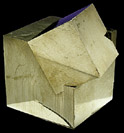|
|
| Formula: | FeS2 |  Click to see a larger image |
||
| Crystal: | Isometric | |||
| Hardness: | 6-6.5 | |||
| Spec. Gr.: | 5.01 | |||
| Streak: | greenish-black | |||
| Cleavage: | a(100), o(111), indistinct | |||
| Location: | Navajún, Spain |
| Pyrite has been known since ancient times. Its name is derived from the Greek PYRITES meaning sparkling in that sparks fly off when struck. It is one of the most common minerals, and is the most abundant ore-bearing mineral. The Incas polished it into mirrors. It carries trace amounts of gold and copper. It weathers into alum shales, which are used to make sulfuric acid. Its crystals are most often striated cubes. Pyrite is brass-yellow, and has a brown-black streak. Spectacular cubes, stacked one upon another, are found in abundance at the Victoria Mine, Navajún, Spain. Crystals of iron pyrites are sometimes used as amulets by the North American Indians, and the belief in their magic power is attested by their presence in the outfit of miscellaneous objects which the medicine men use in the course of their incantations. Because these gleaming yellow crystals are occasionally mistaken for gold, the name "fools gold," has been popularly bestowed upon them. |
|
Bibliography: Svenek, Jaroslav, Minerals, 1987, pg. 68-69. Webb, Frederick, Handbook of American Indians North of Mexico, 1910, pg. 331. |
|
University of California, Santa Barbara—Department of Earth Science Copyright © 2005 Regents of the University of California Send your comments to the Web Page Editor |